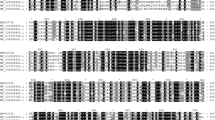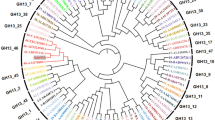Abstract
A novel gene (amyZ) encoding a cold-active and salt-tolerant α-amylase (AmyZ) was cloned from marine bacterium Zunongwangia profunda (MCCC 1A01486) and the protein was expressed in Escherichia coli. The gene has a length of 1785 bp and encodes an α-amylase of 594 amino acids with an estimated molecular mass of 66 kDa by SDS-PAGE. The enzyme belongs to glycoside hydrolase family 13 and shows the highest identity (25 %) to the characterized α-amylase TVA II from thermoactinomyces vulgaris R-47. The recombinant α-amylase showed the maximum activity at 35 °C and pH 7.0, and retained about 39 % activity at 0 °C. AmyZ displayed extreme salt tolerance, with the highest activity at 1.5 M NaCl and 93 % activity even at 4 M NaCl. The catalytic efficiency (k cat/K m) of AmyZ increased from 115.51 (with 0 M NaCl) to 143.30 ml mg−1 s−1 (with 1.5 M NaCl) at 35 °C and pH 7.0, using soluble starch as substrate. Besides, the thermostability of the enzyme was significantly improved in the presence of 1.5 M NaCl or 1 mM CaCl2. AmyZ is one of the very few α-amylases that tolerate both high salinity and low temperatures, making it a potential candidate for research in basic and applied biology.





Similar content being viewed by others
References
Ajayi AO, Fagade OE (2007) Heat activation and stability of amylases from Bacillus species. Afr J Biotechnol 6:1181–1184
Arikan B (2008) Highly thermostable, thermophilic, alkaline, SDS and chelator resistant amylase from a thermophilic Bacillus sp. isolate A3-15. Bioresour Technol 99:3071–3076
Arnold K, Bordoli L, Kopp J, Schwede T (2006) The SWISS-MODEL workspace: a web-based environment for protein structure homology modelling. Bioinformatics 22(2):195–201
Ballschmiter M, Futterer O, Liebl W (2006) Identification and characterization of a novel intracellular alkaline α-amylase from the Hyperthermophilic Bacterium Thermotoga maritima MSB8. Appl Environ Microbiol 72:2206–2211
Benkert P, Biasini M, Schwede T (2011) Toward the estimation of the absolute quality of individual protein structure models. Bioinformatics 27(3):343–350
Bradford MM (1976) A rapid and sensitive method for the quantitation of microgram quantities of protein utilizing the principle of protein–dye binding. Anal Biochem 72:248–254
Chessa J-P, Feller G, Gerday C (1999) Purification and characterization of the heat-labile α-amylase secreted by the psychrophilic bacterium TAC 240B. Can J Microbiol 45:452–457
Coronado MJ, Vargas C, Hofemeister J, Ventosa A, Nieto JJ (2000) Production and biochemical characterization of an α-amylase from the moderate halophile Halomonas meridiana. FEMS Microbiol Lett 183:67–71
D’Amico S, Claverie P, Collins T, Georlette D, Gratia E, Hoyoux A, Meuwis MA, Feller G, Gerday C (2002) Molecular basis of cold adaptation. Philos Trans Royal Soc B: Biol Sci 357:917–925
Danson MJ, Hough DW (1997) The structural basis of protein halophilicity. Comp Biochem Physiol A Physiol 117:307–312
Feller G, Lonhienne T, Deroanne C, Libioulle C, Van Beeumen J, Gerday C (1992) Purification, characterization, and nucleotide sequence of the thermolabile alpha-amylase from the antarctic psychrotroph Alteromonas haloplanctis A23. J Biol Chem 267:5217–5221
Gerday C, Aittaleb M, Bentahir M, Chessa J-P, Claverie P, Collins T, D’Amico S, Dumont J, Garsoux G, Georlette D (2000) Cold-adapted enzymes: from fundamentals to biotechnology. Trends Biotechnol 18:103–107
Gupta R, Gigras P, Mohapatra H, Goswami VK, Chauhan B (2003) Microbial α-amylases: a biotechnological perspective. Process Biochem 38:1599–1616
Hagihara H, Igarashi K, Hayashi Y, Endo K, Ikawa-Kitayama K, Ozaki K, Kawai S, Ito S (2001) Novel α-amylase that is highly resistant to chelating reagents and chemical oxidants from the Alkaliphilic Bacillus isolate KSM-K38. Appl Environ Microbiol 67:1744–1750
Henrissat B (1991) A classification of glycosyl hydrolases based on amino acid sequence similarities. Biochem J 280:309–316
Hutcheon GW, Vasisht N, Bolhuis A (2005) Characterisation of a highly stable α-amylase from the halophilic archaeon Haloarcula hispanica. Extremophiles 9:487–495
Jabbour D, Sorger A, Sahm K, Antranikian G (2012) A highly thermoactive and salt-tolerant α-amylase isolated from a pilot-plant biogas reactor. Appl Microbiol Biotechnol 97:2971–2978
Kobayashi T, Kanai H, Hayashi T, Akiba T, Akaboshi R, Horikoshi K (1992) Haloalkaliphilic maltotriose-forming alpha-amylase from the archaebacterium Natronococcus sp. strain Ah-36. J Bacteriol 174:3439–3444
Laderman K, Asada K, Uemori T, Mukai H, Taguchi Y, Kato I, Anfinsen C (1993) Alpha-amylase from the hyperthermophilic archaebacterium Pyrococcus furiosus. Cloning and sequencing of the gene and expression in Escherichia coli. J Biol Chem 268(32):24402–24407
Lévêque E, Haye B, Belarbi A (2000) Cloning and expression of an α-amylase encoding gene from the hyperthermophilic archaebacterium Thermococcus hydrothermalis and biochemical characterisation of the recombinant enzyme. FEMS Microbiol Lett 186:67–71
Liu J, Zhang Z, Dang H, Lu J, Cui Z (2011a) Isolation and characterization of a cold-active amylase from marine Wangia sp. C52. Afr J Microbiol Res 5:1156–1162
Liu J, Zhang Z, Liu Z, Zhu H, Dang H, Lu J, Cui Z (2011b) Production of cold-adapted amylase by marine bacterium Wangia sp. C52: optimization, modeling, and partial characterization. Mar Biotechnol 13(5):837–844
Lu M, Wang S, Fang Y, Li H, Liu S, Liu H (2010) Cloning, expression, purification, and characterization of cold-adapted α-amylase from Pseudoalteromonas arctica GS230. Protein J 29:591–597
MacGregor E, Janeček Š, Svensson B (2001) Relationship of sequence and structure to specificity in the α-amylase family of enzymes. Biochim Biophys Acta (BBA)-Protein Struct Mol Enzymol 1546:1–20
Madern D, Ebel C, Zaccai G (2000) Halophilic adaptation of enzymes. Extremophiles 4:91–98
Madern D, Camacho M, Rodrı′guez-Arnedo A, Bonete M-J, Zaccai G (2004) Salt-dependent studies of NADP-dependent isocitrate dehydrogenase from the halophilic archaeon Haloferax volcanii. Extremophiles 8:377–384
Mehta D, Satyanarayana T (2013) Biochemical and molecular characterization of recombinant acidic and thermostable raw-starch hydrolysing α-amylase from an extreme thermophile Geobacillus thermoleovorans. J Mol Catal B Enzym 85–86:229–238. doi:10.1016/j.molcatb.2012.08.017
Mijts BN, Patel BK (2002) Cloning, sequencing and expression of an α-amylase gene, amyA, from the thermophilic halophile Halothermothrix orenii and purification and biochemical characterization of the recombinant enzyme. Microbiology 148:2343–2349
Miller GL (1959) Use of dinitrosalicylic acid reagent for determination of reducing sugar. Anal Chem 31:426–428
Pe′rez-Pomares F, Bautista V, Ferrer J, Pire C (2003) α-Amylase activity from the halophilic archaeon Haloferax mediterranei. Extremophiles 7:299–306
Polymenakou PN, Lampadariou N, Mandalakis M, Tselepides A (2009) Phylogenetic diversity of sediment bacteria from the southern Cretan margin, Eastern Mediterranean Sea. Syst Appl Microbiol 32(1):17–26
Qin QL, Zhao DL, Wang J, Chen XL, Dang HY, Li TG, Zhang YZ, Gao PJ (2007) Wangia profunda gen. nov., sp. nov., a novel marine bacterium of the family Flavobacteriaceae isolated from southern Okinawa Trough deep-sea sediment. FEMS Microbiol Lett 271(1):53–58
Qin Q-L, Zhang X-Y, Wang X-M, Liu G-M, Chen X-L, Xie B-B, Dang H-Y, Zhou B-C, Yu J, Zhang Y-Z (2010) The complete genome of Zunongwangia profunda SM-A87 reveals its adaptation to the deep-sea environment and ecological role in sedimentary organic nitrogen degradation. BMC Genomics 11(1):247. doi:10.1186/1471-2164-11-247
Tonozuka T, Ohtsuka M, Mogi S, Sakai H, Ohta T, Sakano Y (1993) A neopullulanase-type α-amylase gene from Thermoactinomyces vulgaris R-47. Biosci Biotech Biochem 57(3):395–3401
Satheesh kumar G, Chandra MS, Mallaiah KV, Sreenivasulu P, Choi Y-L (2010) Purification and characterization of highly thermostable α-amylase from thermophilic Alicyclobacillus acidocaldarius. Biotechnol Bioprocess Eng 15:435–440
Shafiei M, Ziaee A-A, Amoozegar MA (2010) Purification and characterization of an organic-solvent-tolerant halophilic α-amylase from the moderately halophilic Nesterenkonia sp. strain F. J Ind Microbiol Biotechnol 38:275–281
Sharma S, Khan FG, Qazi GN (2010) Molecular cloning and characterization of amylase from soil metagenomic library derived from Northwestern Himalayas. Appl Microbiol Biotechnol 86(6):1821–1828
Siddiqui KS, Cavicchioli R (2006) Cold-adapted enzymes. Annu Rev Biochem 75:403–433
Srimathi S, Jayaraman G, Feller G, Danielsson B, Narayanan PR (2007) Intrinsic halotolerance of the psychrophilic α-amylase from Pseudoalteromonas haloplanktis. Extremophiles 11:505–515
Syed DG, Agasar D, Pandey A (2008) Production and partial purification of α-amylase from a novel isolate Streptomyces gulbargensis. J Ind Microbiol Biotechnol 36:189–194
Tan T-C, Mijts BN, Swaminathan K, Patel BKC, Divne C (2008) Crystal structure of the polyextremophilic α-amylase AmyB from Halothermothrix orenii: details of a productive enzyme–substrate complex and an N domain with a role in binding raw starch. J Mol Biol 378:852–870
Van Der Maarel MJ, Van Der Veen B, Uitdehaag JC, Leemhuis H, Dijkhuizen L (2002) Properties and applications of starch-converting enzymes of the α-amylase family. J Biotechnol 94:137–156
Violet M, Meunier J-C (1989) Kinetic study of the irreversible thermal denaturation of Bacillus licheniformis alpha-amylase. Biochem J 263:665–670
Yamaguchi R, Tokunaga H, Ishibashi M, Arakawa T, Tokunaga M (2010) Salt-dependent thermo-reversible α-amylase: cloning and characterization of halophilic α-amylase from moderately halophilic bacterium, Kocuria varians. Appl Microbiol Biotechnol 89:673–684
Yang SJ, Lee HS, Park CS, Kim YR, Moon TW, Park KH (2004) Enzymatic analysis of an amylolytic enzyme from the Hyperthermophilic Archaeon Pyrococcus furiosus reveals its novel catalytic properties as both an α-amylase and a cyclodextrin-hydrolyzing enzyme. Appl Environ Microbiol 70:5988–5995
Zhang J-W, Zeng R-Y (2007) Purification and characterization of a cold-adapted α-amylase produced by Nocardiopsis sp. 7326 isolated from Prydz Bay, Antarctic. Marine Biotechnol 10:75–82
Acknowledgments
The work was supported by grants from the National Natural Science Foundation of China (NO. J1103510).
Author information
Authors and Affiliations
Corresponding author
Additional information
Communicated by F. Robb.
Rights and permissions
About this article
Cite this article
Qin, Y., Huang, Z. & Liu, Z. A novel cold-active and salt-tolerant α-amylase from marine bacterium Zunongwangia profunda: molecular cloning, heterologous expression and biochemical characterization. Extremophiles 18, 271–281 (2014). https://doi.org/10.1007/s00792-013-0614-9
Received:
Accepted:
Published:
Issue Date:
DOI: https://doi.org/10.1007/s00792-013-0614-9




